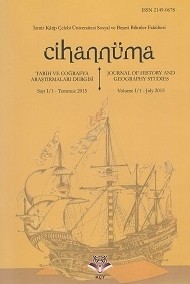Orta çağ Avrupa’sında Çizilen Dünya Haritalarında Ye’cûc ve Me’cûc (Gog ve Magog) Halkının/Ülkesinin Tasviri
The Description of the Folk/Territory of Gog and Magog (Ye’cûc and Me’cûc) in the World Maps Drawned in the Medieaval Europe
Author(s): Zeynep İnan AliyazıcıoğluSubject(s): Museology & Heritage Studies, Maps / Cartography, 13th to 14th Centuries, 15th Century
Published by: İzmir Kâtip Çelebi Üniversitesi, Sosyal ve Beşeri Bilimler Fakültesi
Keywords: Gog and Magog; Mappamundi; Mongols; Jews; Turks;
Summary/Abstract: The general name of the world maps drawn in Medieval Europe is mappamundi. The most common type of mappamundi maps are T-O maps that date back to ancient Greece. The Mappamundi is a scene where both geographical and religious knowledge of the medieval world are depicted. From time to time, among the divine depictions on world maps, Gog Magog and the wall of Alexander the Great stand out. Envisioned as an apocalyptic people, the Gog-and-Magog is depicted on maps in a closed area in the distant corners of the inhabited world, usually in the form of an island or a peninsula. Although the Gog-and-Magog is mentioned as a region or a people in the world maps drawn in the Middle Ages Europe, it is generally not identified with any nation or religious group. However, the threat of the Mongols to Europe in the 13th century caused a connection between the Gog-and-Magog and Mongols. Thus, it has found a Gog-and-Magog on maps since the 1200s. The Gog-and-Magog appears British historian and cartographer Matthew Paris’ work and map, the Vesconte Map, the Catalan Atlas and the Waldseemüller Map and has been usually linked to Mongolians. In Ebstorf and Hereford world maps, a connection is established between the Gog-and-Magog and Turks. In the world maps drawn in the 15th century, the Gog-and-Magog was mostly defined as Jews. In Borgia, Bianco, Andreas Walsperger, Genoese, Ptolemy/Zeit and Rüst/Sporer maps, the Gog-and-Magog appears as the Lost Ten Tribes or Jews. In this study, the depictions of the Gog-and-Magog in the aforementioned maps are examined.
Journal: Cihannüma: Tarih ve Coğrafya Araştırmaları Dergisi
- Issue Year: VII/2021
- Issue No: 1
- Page Range: 1-44
- Page Count: 44
- Language: Turkish

